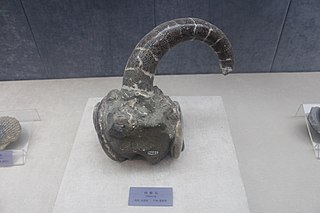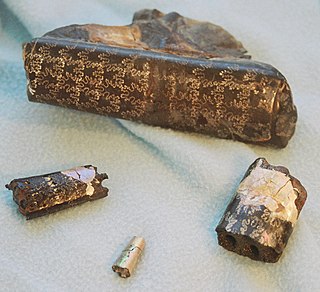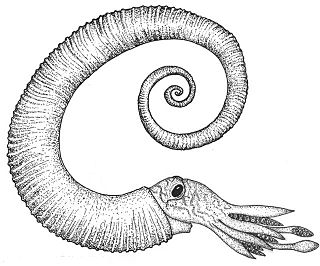
Ammonoids are a group of extinct marine mollusc animals in the subclass Ammonoidea of the class Cephalopoda. These molluscs, commonly referred to as ammonites, are more closely related to living coleoids than they are to shelled nautiloids such as the living Nautilus species. The earliest ammonites appeared during the Devonian, with the last species vanishing during or soon after the Cretaceous–Paleogene extinction event.

Hamites is a genus of heteromorph ammonite that evolved late in the Aptian stage of the Early Cretaceous and lasted into the Cenomanian stage of the Late Cretaceous. The genus is almost certainly paraphyletic but remains in wide use as a "catch all" for heteromorph ammonites of the superfamily Turrilitoidea that do not neatly fit into the more derived groupings. In an attempt to identify clades within the genus, it has been divided up into a series of new genera or subgenera by different palaeontologists, including Eohamites, Hamitella, Helicohamites, Lytohamites, Planohamites, Psilohamites, and Sziveshamites.

Belemnoids are an extinct group of marine cephalopod, very similar in many ways to the modern squid and closely related to the modern cuttlefish. Like them, the belemnoids possessed an ink sac, but, unlike the squid, they possessed ten arms of roughly equal length, and no tentacles. The name "belemnoid" comes from the Greek word βέλεμνον, belemnon meaning "a dart or arrow" and the Greek word είδος, eidos meaning "form".

Nautiloids are a group of marine cephalopods (Mollusca) which originated in the Late Cambrian and are represented today by the living Nautilus and Allonautilus. Fossil nautiloids are diverse and speciose, with over 2,500 recorded species. They flourished during the early Paleozoic era, when they constituted the main predatory animals. Early in their evolution, nautiloids developed an extraordinary diversity of shell shapes, including coiled morphologies and giant straight-shelled forms (orthocones). Only a handful of rare coiled species, the nautiluses, survive to the present day.

Baculites is an extinct genus of heteromorph ammonite cephalopods with almost straight shells. The genus, which lived worldwide throughout most of the Late Cretaceous, and which briefly survived the K-Pg mass extinction event, was named by Lamarck in 1799.

The Ancyloceratina were a diverse suborder of ammonite most closely related to the ammonites of order Lytoceratina. They evolved during the Late Jurassic but were not very common until the Cretaceous period, when they rapidly diversified and became one of the most distinctive components of Cretaceous marine faunas. They have been recorded from every continent and many are used as zonal or index fossils. The most distinctive feature of the majority of the Ancyloceratina is the tendency for most of them to have shells that are not regular spirals like most other ammonites. These irregularly-coiled ammonites are called heteromorph ammonites, in contrast to regularly coiled ammonites, which are called homomorph ammonites.
Beudanticeras is an extinct cephalopod genus from the Late Cretaceous period; Albian and Cenomanian, belonging to the ammonoid subclass and included in the family Desmoceratidae.
Anisoceratidae is an extinct family of heteromorph ammonites which belong to the Ancyloceratina superfamily Turrilitoidea. Members of the family range is from the lower Albian to the upper Turonian. The family is possibly derived from a member of the Hamitidae.

Baculitidae is a family of extinct ammonoid cephalopods that lived mostly during the Late Cretaceous, and often included in the suborder Ancyloceratina.

Lytoceratina is a suborder of Jurassic and Cretaceous ammonites that produced loosely coiled, evolute and gyroconic shells in which the sutural element are said to have complex moss-like endings.

Ammonitina comprises a diverse suborder of ammonite cephalopods that lived during the Jurassic and Cretaceous periods of the Mesozoic Era. They are excellent index fossils, and it is often possible to link the rock layer in which they are found to specific geological time periods.

Nostoceratidae is a diverse family of heteromorph ammonites found throughout the oceans of the world during the Late Cretaceous. The nostoceratids are famous for the bizarre coiling of their shells. Many genera, such as Yezoceras, Ainoceras, Anaklinoceras, and some species of Bostrychoceras and Eubostrychoceras, display, as young shells at least, a helical coiling very similar to the shells of the related family, Turrilitidae. As adults, though, the coils then curve away from the axis of coiling, either as an oxbow-like curve around the juvenile coils as in Ainoceras and Anaklinoceras, or in a simple curved loop beneath the juvenile coils, as in Yezoceras. Other genera form loose coils, sometimes in a spiral, such as those of Madagascarites, Muramotoceras, Hyphantoceras, and the infamously convolute Nipponites.

Exiteloceras is an ammonite genus from the Late Cretaceous.

Nostoceras is an extinct genus of ammonites. The etymology of the name Nostoceras comes from "nostos" meaning return and "ceros" meaning horn, named as such by Alpheus Hyatt because it bends back on itself.
Ancyloceratoidea, formerly Ancylocerataceae, is a superfamily of typically uncoiled and loosely coiled heteromorph ammonoids established by Alpheus Hyatt in 1900, that may contain as many as 11 families, depending on the classification accepted.
Lytocrioceras is a genus of ancyloceratine ammonites from the Lower Cretaceous with a shell that resembles a safety pin. The shell begins as a loosely wound spiral, followed by a straight shaft which makes a U-turn to go back is somewhat the opposite direction, ending in a jog, offset from the original coil.

Ancyloceratidae is a family of heteromorphic ammonites that lived during the Early Cretaceous. Their shells begin as a loose spiral with whorls not touching which then turns into a straight shaft that ends in a J-shape hook or bend at end. Coarse ribbing and spines are common.

Macroscaphites is an extinct cephalopod genus included in the Ammonoidea that lived during the Barremian and Aptian stages of the Early Cretaceous. Its fossils have been found throughout most of Europe and North Africa.

Calycoceras is an extinct genus of cephalopods belonging to the subclass Ammonoidea and family Acanthoceratidae that lived during the Cenomanian stage of the Late Cretaceous, 100-94 Mya. Their shells had ornate ribs.

Macroscaphitidae is an extinct family of ptychoceratoid cephalopods from the subclass Ammonoidea that lived from the Lower Barremian to the Lower Cenomanian stages of the Cretaceous. Fossils of Macroscaphitidae were found all around the world although the abundance of found fossils is rather limited. Known fossils from collections were found largely in Europe, South America and Africa. It is known for some species of which complete specimens were found that these animals developed a hetermorphic shell, i.e. the coiling of the shell was not regular, such that the first whirls formed a planispirally coiled evolute section as seen in homomorphic ammonites, but had an additional straight middle part and a presumably upwards facing aperture. Due to their odd morphology the taxonomic classification of Macroscaphitidae changed often over time since their discovery and may not be finally settled even now.















